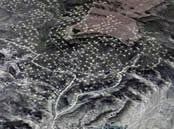 Progress Every Day!
Progress Every Day! Progress Every Day!
Progress Every Day! |
|||||
| HOME | REDUCE | REUSE | RECYCLE | RETHINK | |
|
|
Home > Green Energy Green Energy Why Go Low-Carbon? Usually "green energy" refers to alternative, renewable energy. Alternative to what? Hydrocarbon fuels, including oil, natural gas, and coal, which have been the workhorses of the world economy for over 200 years but which are now falling into carbon disrepute. Climate Change. Carbon is an element like any other, and you may wonder how carbon became synonymous with "evil" in some quarters! The short answer is that scientific data indicate that atmospheric levels of carbon dioxide (CO2) have risen steadily since the beginning of the Industrial Revolution, and this rise is correlated with changes in the heat balance of the earth. Atmospheric chemists explain that CO2, and other greenhouse gases such as methane, in the upper atmosphere are preventing heat from escaping out into space (similar to the greenhouse effect when sunlight enters class windows and heat is retained). The carbon released by the burning of hydrocarbons is carbon that was stored in plant and animal tissues, then buried over millions of years. The release of this buried carbon might seem just part of the earth's global carbon cycle, and in fact it is. The problem comes from the great speed with which this long-stored carbon is being released by human activity. Air Quality. The largest single source of electricity generation in the U.S. is coal-fired power plants. Burning of coal releases mercury, sulfur and nitrogen oxides, and particulate matter, in addition to carbon dioxide. In the U.S., regulations are in the works to require reductions in mercury, sulfur oxides, and nitrogen oxides from coal-fired plants. Despite concerns about emissions from coal combustion, the considerable U.S. coal resource and the relatively low cost of coal-fired electricity generation have kept this fuel "on the front burner." Researchers are working to develop "clean coal" technologies and to capture and store carbon from coal combustion. However, these options are not yet feasible. (Here's a very funny "video" on the topic.) Oil Imports. Even people who remain unconvinced about scientific concerns over carbon in the atmosphere find reason to look for alternative sources of energy. Rising global demand for energy is pushing up prices for oil and natural gas, and political instability in petroleum producing regions may disrupt supplies. In addition, petroleum supplies are not renewable and finds of petroleum reserves are no longer keeping pace with extraction and use.
Green Jobs. Alternative energy sources have been gaining momentum, but remain just a small percent of electricity generation in the U.S. The push for alternative energy, and other technologies to reduce emissions of greenhouse gases, presents opportunities for business and the potential for new "green collar" jobs. Investment in alternative energy is creating opportunities in many job categories, including science and technology; energy consulting/auditing; design, manufacture, and installation of solar panels and wind turbines; and marketing.
From the Present to the Future For electric power generation, alternative energy systems can be deployed in two circumstances: as an additional source of peak-load power to regional electrical grids, or in smaller scale applications for residential or micro-grid power. Alternative energy also may power "green vehicles" (e.g., plug-in electric vehicles or vehicles that run on ethanol fuels made from plant matter). The transition from our current energy system to a greener, lower carbon energy future will not be an abrupt, overnight switch. But, to get there tomorrow we must start today. Advances will be needed in energy generation and storage technologies. Investment will be required to increase transmission capacity to get renewable electricity to demand centers, and to provide infrastructure such as fueling/charging stations for vehicles. Sources of Electrical Power in the U.S. (2006)
To learn more about alternative energy options, click on your choice below: |
BP Solar operates a manufacturing facility in Frederick, MD that employs over 500 workers.
 View satellite images of natural gas development fields at SkyTruth.org
|
||||||||||||||||||||||||||||||||||||||||||||||||
|---|---|---|---|---|---|---|---|---|---|---|---|---|---|---|---|---|---|---|---|---|---|---|---|---|---|---|---|---|---|---|---|---|---|---|---|---|---|---|---|---|---|---|---|---|---|---|---|---|---|---|
| Copyright © 2008. All Rights Reserved. | About | Sitemap | ||||||||||||||||||||||||||||||||||||||||||||||||||
This site is not affiliated with Green WorksTM, a registered trademark of The Clorox Company. |
||||||||||||||||||||||||||||||||||||||||||||||||||